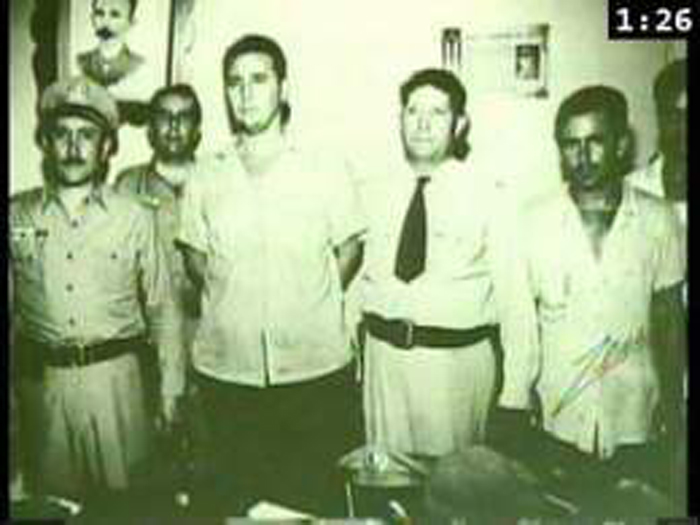
Nobody expected it: the young lawyer Fidel Castro Ruz, the main defendant among those who would be tried from that September 21, 1953 for the attacks on the Moncada and Carlos Manuel de Cespedes garrisons, was finally transformed, later on, from defendant to accuser from his shocking self-defense, with a plea that went down in posterity as History will absolve me.
During the trial, which opened that day in the Plenary Hall of the Palace of Justice in Santiago de Cuba, another truth would come to light, showing that the young members of the revolutionary movement that organized the actions, determined to honor the Apostle in the year of his centenary, were not only courageous in their determination to fight for freedom, but were also guided by a deep ideology and a political program.
Months before, Fidel Castro had taken on the task of organizing and guaranteeing the indispensable military training to a sort of patriotic force made up of some 1,200 students, workers and public employees, mostly affiliated to the orthodox movement, which had been headed by the prestigious Eduardo Chivas.
After the military coup that had placed him in power on March 10, 1952, Fulgencio Batista had given more than enough proof of his surrender to foreign power and the national oligarchy, under repressive and dictatorial methods. He mercilessly persecuted not only socialists and communists but also all progressive demands for justice.
Some 160 members of the secretly trained youth contingent decided to accompany Fidel in the assaults on the military fortresses of Santiago de Cuba and Bayamo, respectively.
Due to tactical failures that surprised them in the theater of operations, they did not achieve their objectives: to take the military garrisons and give the weapons to the people. The tyranny reacted in time to unleash a massacre that killed combatants on the battlefield, and also defenseless prisoners, once disarmed.
Taken prisoner a few days later, Fidel was kept confined for 76 days. He was subsequently subjected to a rigged trial, in which his procedural rights were disrespected. His forceful exposure further alerted the tyrant who, like all his ilk, feared the brave, the truth and its bearers.
The young leader of the movement and the other survivors were sentenced. The leader's sentence stipulated 15 years of imprisonment in the Model Prison, in the then Isle of Pines.
In the trial that began on September 21 under the name of Cause 37, 122 defendants were tried, in a process that took place in different scenarios and on different dates.
The first hearing took place on that day at the Palace of Justice. Another enclave was the Saturnino Lora Hospital, where Fidel Castro was tried on October 16, in a small room. There he was subjected to humiliations and arbitrariness in the due process. But, although they tried, they could not prevent him from exercising his self-defense.
The leader was categorical when he declared himself the leader of the assailants to the Moncada Garrison in Santiago de Cuba and the Carlos Manuel de Cespedes in Bayamo.
With a session crowded with the public, as required by law, the dictatorship summoned many soldiers who tried to frighten those present with their bayonets. The presence of 26 journalists was authorized but the entry of photographers was forbidden.
Fidel could not be denied to make his self-defense, but he had to answer the questions of the prosecutor and magistrates beforehand, after hearing the charges against him.
His plea initially denounced the barbaric murders and torture of his fellow prisoners, and then moved on to the political foundations of the struggle, with the contribution of truthful data on the reality of the people, with their rights violated and an economic performance that only favored the privileged minority. Assassinations, imprisonment or torture were the answer to those who fought against these excesses.
He highlighted the homage to the memory of Jose Marti and proclaimed him as the inspirer and intellectual author of the patriotic actions.
The juridical bases supporting his defense were marked by him as part of the essential assumptions of the law.
With History will absolve me -a name derived from the famous phrase: Condemn me, it doesn't matter, History will absolve me-, Cubans saw the birth of what was later called the Moncada Program, the most important body of objectives to be achieved by the Revolution once the longed-for triumph was achieved, which occurred years later.
After being imprisoned in the Isle of Pines, Batista was forced to release Fidel and the other assailants in mid-May 1955. The leader immediately founded the 26 July Revolutionary Movement and went into exile in Mexico to organize the definitive charge and return to combat. We know it well: he did so.
Sidebar

 Agencia Cubana de Noticias
Líder en información nacional
Agencia Cubana de Noticias
Líder en información nacional








Nos reservamos el derecho de no publicar los comentario que incumplan con las normas de este sitio